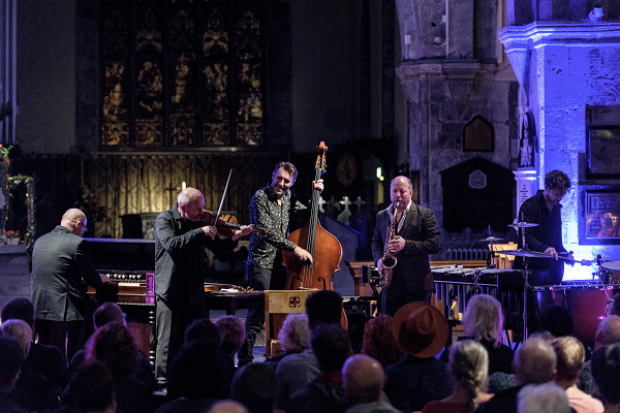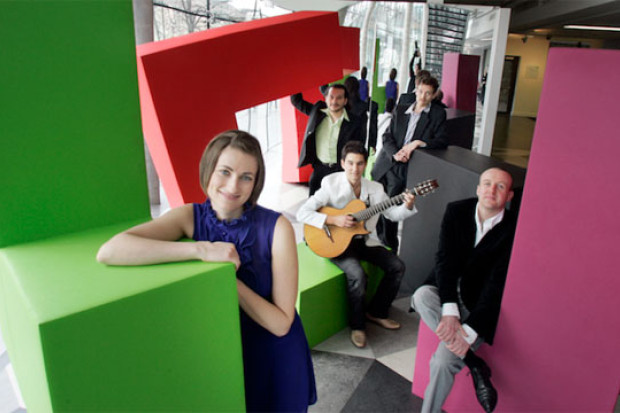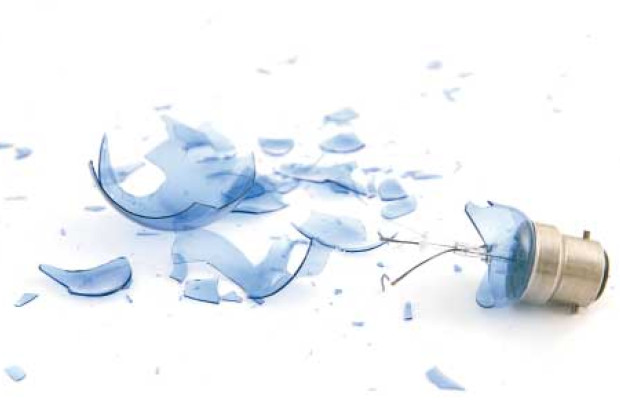Improvising the Voice of America
Rather unusually for a festival director, Ronan Guilfoyle doesn’t carry a mobile phone. You wonder how long this state of affairs will last once February’s RTÉ Living Music Festival, of which he is this year’s artistic director, kicks in. But Guilfoyle is quietly confident. It’s not that he wants to be out of reach, it’s simply that all his work is done: the programme is set, the musicians contracted, the halls booked. He radiates a feeling of quiet excitement at the prospect of actually hearing all these concerts he’s put together. Central to them is the music of this year’s Featured Composer, recently described by the San Francisco Chronicle as the ‘Voice of America’: John Adams.
The focus on Adams’ music was RTÉ’s idea, not Guilfoyle’s, but, he says, ‘it could have been’: the values of Adams’ music are ‘very much in keeping with a lot of the things that I believe in musically’ – approachability for one thing. Guilfoyle describes Adams’ work as an ‘impressive balancing act between intellectual rigour and sheer physicality’, a relationship that not all contemporary music has made work. Propulsive rhythms, a fantastic sense of orchestral colour, and tonal harmonies, often with a jazz tinge: these, coupled with Adams’ mastery of the craft of composition, makes it not surprising that he’s America’s most performed living composer.
Whatever his present status as his country’s unofficial ‘composer laureate’, Adams’ career hasn’t always been plain sailing. Having established his voice in the later 1970s as a sort of second-generation minimalist with works like Phrygian Gates and Shaker Loops, he moved away from his experimental roots and closer to the mainstream with a series of orchestral works that manifested his sureness of touch (among them Harmonielehre and the choral-orchestral Harmonium), music (as Guilfoyle puts it) whose ‘emotional bandwidth was a lot wider’. Adams scored huge successes with these works, notably his first opera Nixon in China, now widely regarded as a contemporary classic. (Against these successes, which now seem so secure, we must remember incidents such as a New York Philharmonic audience leaving in droves during a 1987 performance of Harmonielehre, an energetic and engaging score.)
A huge critical storm attended his second opera, The Death of Klinghoffer, the true story of the murder by Palestinian terrorists of a Jewish-American tourist aboard the Italian cruise ship Achille Lauro in the mid-80s, although here the controversies had more to do with the story than the music. (Adams has posted the controversies on his website – see for example the Guardian article ‘The Witch Hunt’ at www.earbox.com/inter027.html.) Also controversial, but for an entirely different reason, is the New York Philharmonic commission On the Transmigration of Souls, written possibly a bit too quickly after 9/11, which tends to evoke extreme reactions in listeners: emotional catharsis for some, emotional manipulation to others.
Having received Adams as a given, Guilfoyle set about selecting various of his works for performance at the festival (Lollapalooza, Century Rolls, Harmonielehre, John’s Book of Alleged Dances, Hallelujah Junction, Shaker Loops, Road Movies, Gnarly Buttons, Scratchband, Chamber Symphony), some of which have not yet been performed in Ireland. Then he came up with an original idea that personalises the festival: to juxtapose contemporary art music with contemporary jazz. Besides his work as a composer, Guilfoyle is one of the country’s finest improvisers (and instigator of the first jazz degree programme in Ireland, at Dublin’s Newpark Music Centre). This combination of composed music and improvised music is a first for the Living Music Festival.
Guilfoyle deplores the fact that there is ‘far too much ghettoisation’, not only of jazz but also of contemporary music; audiences for one might get a lot out of listening to the other. He says there is already ‘a lot of crossover’ between the two forms, starting with the fact that most jazz musicians nowadays are classically trained, and are as obsessed with complex materials – irregular rhythms, dissonant harmonies, extended instrumental techniques – as are contemporary composers. Guilfoyle also has a marked preference for music that, put simply, has a beat: whether the music is composed or improvised is a secondary concern (see his article ‘Contemporary Music?’ in the Nov-Dec 2005 JMI). Adams’ music manifests what Guilfoyle describes as ‘inclusivity’, incorporating elements from vernacular as well as highbrow musical traditions. When they met in London last August to discuss the festival they soon found themselves immersed in a discussion of the chord changes in John Coltrane’s Giant Steps.
Adams himself has connections with jazz, although mainly with that of a previous era. His father played the clarinet, and his mother sang in musicals and with big bands. His grandfather ran a dance hall and the family would go there to play music during the summer. Duke Ellington’s band played there once, and the young John was allowed to go onstage and sit on the piano bench next to the great man. Occasionally you can hear the jazz influence in some of the works to be played in February: the last movement of Gnarly Buttons, for example, a ballad-like item entitled ‘Put Your Loving Arms Around Me’; the piano concerto Century Rolls, which has hints of Duke Ellington and Jelly Roll Morton, of bop and swing, one level below the surface; or the opening movement of Road Movies, for violin and piano, entitled ‘Relaxed Groove’.
The festival that Guilfoyle has come up with therefore features musicians expert in contemporary composed music, in contemporary improvised music, and occasionally in both. Among the former are the National Symphony Orchestra, the RTÉ Vanbrugh Quartet, the Crash Ensemble, the D’Arcy Quartet, and the London Sinfonietta with Sound Intermedia. Among the latter are Jim McNeely and the Stockholm Jazz Orchestra, Tim Berne’s Big Satan, the Irish trio White Rocket and the American trombonist Ed Neumeister. One of the most provocative juxtapositions may be a piano recital (Sunday 18th, 2pm) with, in the first half, the complete Études for piano by the late György Ligeti (eighteen in total, lasting about 55 minutes, one of the pinnacles of the contemporary piano repertory) played by Rolf Hind; and in the second half, an improvised set by the brilliant Russian-American pianist Simon Nabatov. (‘I think the piano will have to be taken out and shot afterwards’, quips Guilfoyle.) There are two festival commissions – an extended piece by the young Irish jazz pianist Greg Felton, member of the trio White Rocket(Sunday 18th, 12.30pm); and a work for piano quartet plus improvising trombone by Ed Neumeister. Although it’s not a festival commission, there’s also a new work by Kevin Volans for two pianos and strings in the Crash Ensemble’s concert on Saturday 17th at 6pm.
My own favourite works of Adams (I thought you’d never ask) tend to be his smaller-scale pieces, perhaps perversely so, as Adams has written relatively little chamber music. I like the quirkiness of John’s Book of Alleged Dances, his (so far) only string quartet, in which the four live players are pitted against pre-recorded samples of prepared piano, grinding out unusual and not-obviously-danceable backing tracks. I like also the high energy and unpretentiousness of the two-piano piece Hallelujah Junction, named after a small truck stop on Highway 49 near the California-Nevada border close to where Adams has a small cabin (the hideaway where he does much of his composing).
A cynic might claim that focusing this year’s RTÉ Living Music Festival around another famous American composer hard on the heels of Steve Reich last year is an attempt to match the considerable success, artistically and in terms of audience size, of last February’s festival. But Guilfoyle counters this. Does new music have to play only to small audiences? ‘I love the idea of serendipity’, he says, ‘of juxtaposition by accident’. You get the feeling that there may be a number of such happy accidents this February.
Published on 1 January 2007
Bob Gilmore (1961–2015) was a musicologist, educator and keyboard player. Born in Carrickfergus, Northern Ireland, he studied at York University, Queen's University Belfast, and at the University of California. His books include Harry Partch: a biography (Yale University Press, 1998) and Ben Johnston: Maximum Clarity and other writings on music (University of Illinois Press, 2006), both of which were recipients of the Deems Taylor Award from ASCAP. He wrote extensively on the American experimental tradition, microtonal music and spectral music, including the work of such figures as James Tenney, Horațiu Rădulescu, Claude Vivier, and Frank Denyer. Bob Gilmore taught at Queens University, Belfast, Dartington College of Arts, Brunel University in London, and was a Research Fellow at the Orpheus Institute in Ghent. He was the founder, director and keyboard player of Trio Scordatura, an Amsterdam-based ensemble dedicated to the performance of microtonal music, and for the year 2014 was the Editor of Tempo, a quarterly journal of new music. His biography of French-Canadian composer Claude Vivier was published by University of Rochester Press in June 2014. Between 2005 and 2012, Bob Gilmore published several articles in The Journal of Music.














